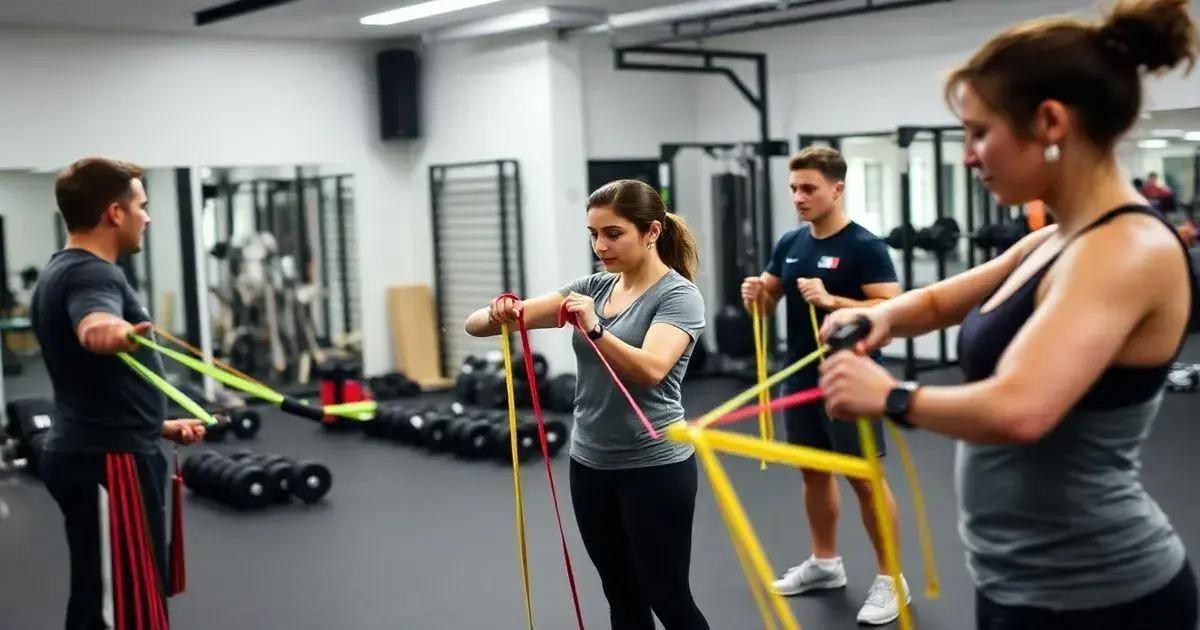Combining resistance bands and weights in workouts enhances strength, flexibility, and overall fitness by engaging multiple muscle groups effectively. Safety tips include using proper equipment, maintaining correct form, and ensuring hydration while following diverse exercise routines to achieve maximum gains.
Are you looking to enhance your workout routine? Combining resistance bands and weights in workouts can lead to unparalleled strength and flexibility gains. By incorporating these two tools, you create a comprehensive training experience that targets multiple muscle groups and adapts to various fitness levels. In this article, we will discuss the benefits of using both resistance bands and weights, explore effective exercises to maximize your training, and provide essential tips to ensure you have a safe and productive workout.
Benefits of Combining Resistance Bands and Weights

Combining resistance bands and weights in your workout routine can offer a variety of benefits that enhance strength training. First, this combination allows you to target different muscle groups in one session, maximizing your time spent at the gym. By utilizing resistance bands, you can engage stabilizing muscles that free weights alone may not activate.
Increased Versatility
The versatility of both resistance bands and weights means you can easily switch between exercises. This keeps your workouts fresh and helps prevent boredom. You can adjust the resistance level of bands while keeping the weights the same, allowing for a tailored training experience suitable for any fitness level.
Enhanced Muscle Activation
One notable benefit is the enhanced muscle activation. Resistance bands provide continuous tension throughout the movement, which can lead to improved strength gains and muscle development. This means that as you lift weights, the tension from the bands ensures your muscles are engaged continuously, increasing the effectiveness of each rep.
Improved Range of Motion
Resistance bands also allow for a greater range of motion. This can be particularly beneficial for functional movements that mimic everyday activities. By integrating bands, you can improve your flexibility and mobility, making daily tasks easier.
Reduced Risk of Injury
Another advantage is the reduced risk of injury. Resistance bands provide a safer way to add resistance to your workouts as they are less jarring on the joints. By combining these with weights, you can engage in a comprehensive training program that minimizes stress on your body while still challenging your muscles.
Overall, combining resistance bands and weights can help you achieve better results, engage your muscles more effectively, and make workouts enjoyable.
Best Exercises with Resistance Bands and Weights

When it comes to maximizing your workout, incorporating both resistance bands and weights is essential. Here are some of the best exercises you can perform using these tools together.
Bicep Curls
Start by standing on the middle of the resistance band while holding a weight in each hand. Perform a standard bicep curl by bringing the weights up toward your shoulders while maintaining tension in the band. This adds extra resistance at the top of the movement.
Squats with Resistance Bands and Weights
Place the resistance band just above your knees and hold weights at your sides. Perform a squat as you normally would, keeping your chest up and core engaged. The band will challenge your stability, while the weights add intensity to the movement.
Chest Press
For this exercise, anchor the resistance band behind you and hold a weight in each hand, palms facing forward. Step forward to create tension in the band. Push the weights forward at shoulder level, maintaining tension in both the weights and the band for a full range of motion.
Deadlifts
Using a resistance band and weights, stand on the band with feet shoulder-width apart while holding the weights. Keeping your back straight, bend at the hips and knees to lower the weights towards the ground. As you lift back up, the band adds extra resistance, forcing your muscles to work harder.
Seated Rows
Sit on the floor with your legs extended. Loop the resistance band around your feet and hold a weight in each hand. Pull the weights towards your torso while leaning slightly back. The combination of bands and weights focuses on your back muscles, enhancing strength and stability.
These exercises offer a comprehensive routine that effectively incorporates both resistance bands and weights, ensuring a balanced workout targeting multiple muscle groups.
Tips for Effective Workout Routines

To get the most out of your workouts, especially when combining resistance bands and weights, consider these effective tips.
Set Clear Goals
Start by setting specific fitness goals. Whether you want to build strength, increase flexibility, or improve endurance, knowing your objectives helps guide your routine and keep you motivated.
Warm Up Properly
Always warm up your muscles before starting your workouts. A light 5-10 minute cardio session, such as jogging or jumping jacks, followed by dynamic stretches prepares your body for the upcoming exercises, reducing the risk of injury.
Mix Up Your Exercises
Incorporating a variety of exercises keeps your routine interesting and ensures that different muscle groups are engaged. Rotate between resistance band workouts, weightlifting, and bodyweight exercises to develop well-rounded strength and avoid plateaus.
Use Proper Form
Focus on maintaining proper form during all exercises. This not only enhances effectiveness but also minimizes the risk of injuries. If you’re unsure how to perform a particular movement correctly, consider seeking guidance from a fitness professional.
Stay Hydrated
Keeping hydrated during workouts is crucial for optimal performance. Drink water before, during, and after your sessions to keep your energy levels up and aid recovery.
Take Rest Days
Rest days are just as important as workout days. Giving your body time to recover allows for muscle repair and growth. Aim for at least one or two rest days each week to enhance overall progress.
By implementing these tips, you can create effective workout routines that help you get the best results from your resistance bands and weights.
Safety Tips for Weight and Band Training

Safety is crucial when training with weights and resistance bands. Here are key tips to ensure you train safely while maximizing your gains.
Use Proper Equipment
Before starting your workout, ensure that your equipment is in good condition. Check for any signs of wear or damage on your resistance bands and weights. Using damaged equipment can lead to injuries.
Start with a Warm-Up
Always warm up your body before training. A good warm-up prepares your muscles and joints for exertion, reducing the risk of strains and sprains. Include dynamic stretches and light cardio to get your blood flowing.
Learn the Correct Techniques
Focusing on the right techniques is vital for preventing injuries. If you’re new to an exercise, watch instructional videos or ask a trainer for guidance. Start with lighter weights to practice proper form before progressing to heavier loads.
Listen to Your Body
Pay attention to how your body feels during workouts. If you feel pain or discomfort, stop the exercise. Pushing through pain can result in serious injuries, so it’s better to take a break if you need one.
Secure Your Bands Properly
When using resistance bands, ensure they are anchored securely, especially for exercises that involve pulling or pushing. An unstable band can snap back and cause injury. Check your grip and make sure your feet are securely positioned.
Stay Hydrated and Nourished
Drink plenty of water before, during, and after your workouts. Staying hydrated helps your muscles recover and perform better. Also, eat a balanced diet to fuel your body for your training sessions.
By following these safety tips, you can enjoy a more effective and injury-free workout experience with resistance bands and weights.
In summary, combining resistance bands and weights offers a powerful approach to fitness
By integrating both tools into your workout routine, you can maximize strength gains, enhance muscle engagement, and improve overall fitness.
Implementing the best exercises with proper techniques, while focusing on safety and hydration, ensures more effective and injury-free sessions. Setting clear goals and mixing up your workouts keeps motivation high and progress steady.
Remember to follow recommended safety tips, such as using equipment appropriately and listening to your body. With consistent effort and adherence to these practices, you can achieve impressive results while enjoying the journey towards your fitness goals.
FAQ – Frequently Asked Questions about Combining Resistance Bands and Weights
What are the benefits of using both resistance bands and weights?
Combining resistance bands and weights enhances muscle activation, increases versatility in workouts, and can improve overall strength and flexibility.
How do I ensure safety while using resistance bands and weights?
To ensure safety, always check your equipment for damage, practice proper form, warm up before workouts, and listen to your body’s signals.
What are some effective exercises to combine resistance bands and weights?
Effective exercises include bicep curls, squats, chest presses, deadlifts, and seated rows, allowing you to target multiple muscle groups.
How can I create a balanced workout routine?
Set clear goals, mix various exercises, follow a structured plan, and ensure to incorporate rest days to allow for recovery and muscle growth.
Is it necessary to use weights if I am using resistance bands?
While resistance bands alone can provide an effective workout, combining them with weights adds extra resistance and challenges your muscles differently, leading to improved results.
How often should I train with resistance bands and weights?
It’s recommended to train with resistance bands and weights at least 2-3 times per week, allowing adequate rest days to prevent overtraining.












